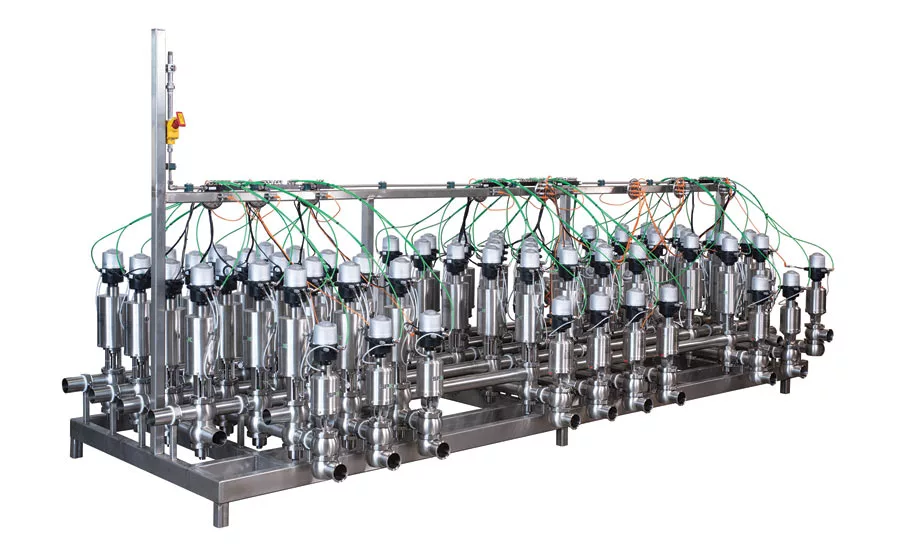Technology spurs customization of beverage processing automation
3-D modeling enables easy integration into production systems

Food and beverage processing equipment continues to be high demand. Requests for automation integration and advancements in customized equipment could drive the market past $78 billion by 2022, according to business consulting firm Frost & Sullivan. Changing dietary preferences worldwide, improved economic conditions in emerging nations as well as a demand for healthy, safe food and beverages, has influenced the development of processing and packaging machinery that support those trends, thereby creating an upswing in the market. Because of this upswing, the firm predicts that the global food and beverage processing and packaging market will expand at a compound annual growth rate (CAGR) of 4.1 percent from 2017 to $78.6 billion in 2022.
“With increasing food and beverage product demand and a growing emphasis on food safety, food processors are reliant on equipment manufacturers to provide processing and packaging equipment that is agile and utilizes advanced technologies to minimize energy usage, operate at a higher efficiency and improve yield,” said Arun Ramesh, team lead, agriculture and nutrition in visionary science at San Antonio, Texas-based Frost & Sullivan, in a statement.
Efficiency, flexibility and quality are cornerstones of any successful beverage operation. Breweries and bottling companies are among the companies using Botec (Batch Oriented TECnology) F1, an easy-to-use IT process control system from Franklin, Wis.-based Krones Inc. that monitors and controls the consistency of every product, batch after batch, time after time, the company says.
Atlanta-based New Realm Brewing and co-founders Mitch Steele and Carey Falcone are among the brewers adopting the technology. They purchased a fully automated 20-barrel, 4-vessel Steinecker MicroCube brewhouse equipped with Botec F1. “The setup allowed New Realm a capacity of 20,000 [barrels] a year at full production with the ability to keg, bottle and can their beer,” Falcone said in a statement.
Aside from processing equipment for the brewing industry, during the past five years, experts have witnessed “significant growth” of high-pressure processing (HPP) within the beverage industry.
“HPP has proven to be an effective non-thermal preservation technology that enhances food safety, significantly increases refrigerated shelf life, while at the same time, maintaining the quality organoleptic properties of the beverage,’’ says Mark Fleck, HPP consultant at Universal Pure, Villa Rica, Ga.
Noting the great acceptance of HPP products worldwide, Roberto Peregrina, director of Miami-based Hiperbaric USA, affirms that HPP is no longer a novel technology due to the “booming acceptance” of cold-pressed juices and functional drinks and the batch processing’s proven ability to extend shelf life and maintain the organoleptic properties of the beverage.
“This enabled companies to expand to new markets and obtain national distribution in some cases like Suja and Evolution Fresh,” Peregrina says. “This is also the application with most acceptance within the HPP world. In the past three years, we have sold over 50 percent of our machines to this sector.”
In addition to reliable, well-designed and easy-to-use automation processing systems, beverage manufacturers’ desire machines that autonomously self-diagnose and troubleshoot problems with a high degree of remote support capability, says Kurt Wagner, engineering director for Tampa, Fla.-based Trans-Market, a member of the Krones Group. “There is also a demand for handheld wireless HII terminal configuration allowing the operators flexibility of being able to move around and still have access to graphical information assisting in troubleshooting and problem solving,” he adds.
Adaptable, configurable process control equipment and software also is crucial, says Joe Mazzola, group manager at McEnery Automation, St. Louis. As a certified member of the Control System Integrators Association (CSIA), McEnery offers process control equipment (Allen-Bradley PLCs) and software (Rockwell Software) that easily adapts to ever-changing process operations.
“The PLCs can seamlessly connect to a variety of instrumentation from traditional 4-20 signals to a multitude of communication protocols for more complex instrumentation,” Mazzola says. “Software like FactoryTalk Batch simplifies new recipe development and ensures consistency in batch execution.
“More and more devices are being connected via networks, allowing more complex data to be collected and stored from each device,” he continues. “Analytics software is able to use this data to identify process points that can be adjusted to reduce energy use in heating or pumping applications, reduction of expensive ingredients during batching or blending, or durations of cleaning processes.”
Design should come first when it comes to processing automation equipment, says Trans-Market’s Wagner. “One item that we offer is innovative mix-proof valve manifold skids designed with 3-D modeling for easy integration into production systems,” he says. “Knowing the ingredient and final product properties, the processing automation equipment can be sized properly to handle the different formulations during the design and implementation stages.” BI
Looking for a reprint of this article?
From high-res PDFs to custom plaques, order your copy today!






